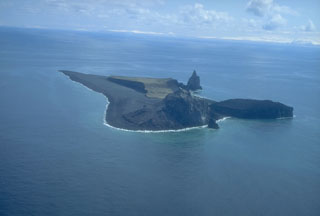Report on Bogoslof (United States) — 2 August-8 August 2017
Smithsonian Institution / US Geological Survey
Weekly Volcanic Activity Report, 2 August-8 August 2017
Managing Editor: Sally Sennert.
Please cite this report as:
Global Volcanism Program, 2017. Report on Bogoslof (United States) (Sennert, S, ed.). Weekly Volcanic Activity Report, 2 August-8 August 2017. Smithsonian Institution and US Geological Survey.
Bogoslof
United States
53.93°N, 168.03°W; summit elev. 150 m
All times are local (unless otherwise noted)
AVO reported that during 2-6 August no activity at Bogoslof was observed in mostly cloudy satellite images, and no activity was detected in seismic, infrasound, or lightning data. An explosive eruption began at 1000 on 7 August, following more than an hour of increased seismicity. A pilot reported that an ash cloud rose to an altitude of 9.8 km (32,000 ft) a.s.l., prompting AVO to raise the Aviation Color Code (ACC) to Red and the Volcano Alert Level (VAL) to Warning. The eruption lasted about three hours, and was longer lived than most of the events in the eruptive sequence that started in December 2016. At 1341 AVO noted that the ash plume had formed a continuous cloud which stayed attached to the volcano and drifted S. The ACC was lowered to Orange and the VAL was lowered to Watch on 8 August. Satellite images acquired on 8 August showed a significant expansion of the island towards the N with thick tephra deposits around the vent area forming a new crater lake.
Geological Summary. Bogoslof is the emergent summit of a submarine volcano that lies 40 km N of the main Aleutian arc. It rises 1,500 m above the Bering Sea floor. Repeated construction and destruction of lava domes at different locations during historical time has greatly modified the appearance of this "Jack-in-the-Box" volcano and has introduced a confusing nomenclature applied during frequent visits by exploring expeditions. The present triangular-shaped, 0.75 x 2 km island consists of remnants of lava domes emplaced from 1796 to 1992. Castle Rock (Old Bogoslof) is a steep-sided pinnacle that is a remnant of a spine from the 1796 eruption. The small Fire Island (New Bogoslof), about 600 m NW of Bogoslof Island, is a remnant of a lava dome formed in 1883.
Source: US Geological Survey Alaska Volcano Observatory (AVO)

